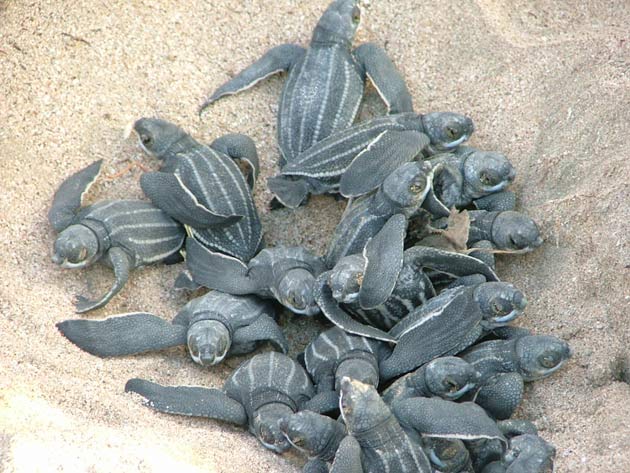Beach Patrols Help Sea Turtles Rebound

Beach patrols to save dwindling leatherback sea turtle populations appear to be working on the Caribbean island of St. Croix.
Fewer than 30 females nested on a 3-mile strip of the island called Sandy Point in the 1980s. The number grew to 186 by 2001, according to a new study in the journal Biological Conservation. Meanwhile, the number of hatchlings rose from 2,000 to more than 49,000.
This year looks strong too, the scientists reported today.
Promising work
Although leatherback turtles are at serious risk of global extinction, the rise of nesting populations on St. Croix holds promise for others around the world, the researchers said. It is the first study to link nest conservation to an increase in leatherback populations.
"The reason we were able to do this was because of the consistent effort on the beach: patrols carried out every night, all night, every year for the entire nesting season," said Peter Dutton, a researcher with the U.S. National Marine Fisheries Service and principal investigator of Earthwatch’s Saving the Leatherback Turtle project.
Dutton and his wife, Donna Dutton of Ocean Planet Research, were among those who patrolled the beaches to protect nest sites and to relocate those that had been built below the waterline and would otherwise have been destroyed.
Sign up for the Live Science daily newsletter now
Get the world’s most fascinating discoveries delivered straight to your inbox.
"Donna and I sometimes wondered if all the sleepless night we spent walking the beaches, getting bit by bugs, soaked by the rain, covered in sand...if all the efforts would make a difference," Dutton said. "We would watch the hatchlings get out into the surf and be gobbled up by voracious fish in the moonlight.
Only a handful of turtles returned in the early years of the project. Dutton said the team is gratified they "stuck with it long enough to witness the rewards, as those hatchlings started coming back in larger numbers as adults years later."
More to do
Leatherback turtle populations have declined due to human impacts on nesting beaches and destructive fishing practices like longline fisheries, Dutton and his colleagues say.
On the Pacific coast of Costa Rica, more than 120 turtles nested this season, nearly twice last season’s count, but still a 90 percent drop from two decades ago. Eastern Pacific leatherback populations have virtually collapsed.
"There has been much effort placed in reducing leatherback mortality from bycatch at sea," Dutton said. "It is also essential to enact conservation measures to increase hatchling production if we hope for long term recovery of depleted leatherback populations."
- GALLERY: Rich Life Under the Sea
- Sea Turtles Hunted to Brink, Study Finds
- Fishermen Reduce Sea Turtle Death By Changing Bait
- Ocean Loaded with Deadly 'Ghostnets'










